Friday, 23 May 2014: Béziers to Narbonne, via the flower market
Written 23 May
Quiet day at the Béziers Ibis Budget. The breakfast buffet included all the usual suspects but was set for only about eight guests. I seemed to be the first. The two middle-aged British guys who came next seemed to be part of a larger group and were planning train schedules. I couldn't be sure, but I think they're bicycling between train rides. The previous day, the Montpellier airport had been positively overrun with Brits. Interestingly, the breakfast buffet here includes an electric kettle, so one can make real tea with actual boiling water—clearly a British influence.
I grabbed a croissant for David, because he had not come down by the time breakfast closed at 9:30 a.m.
Written 24 May
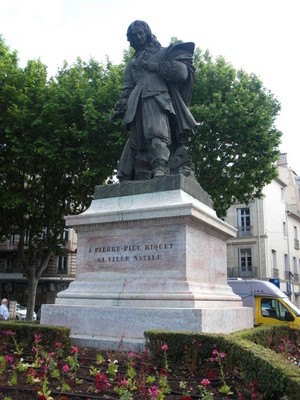
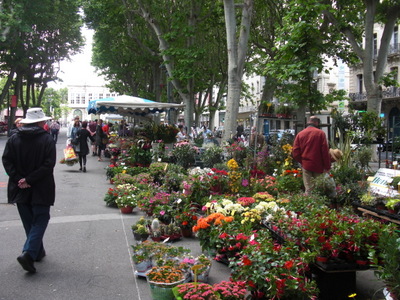 When he did appear, we strolled up the street toward the market place and famous statue of Pierre Paul Riquet (1609–1680), shown here on the left. He's the local native son who finally solved the problem of getting the Canal du Midi over the Seuil de Naurouze (a ridge that had baffled all previous attempts) so that it could at last join the Atlantic to the Mediterranean—a huge boon to shipping. To get a canal over a high spot that you can't cut a slot through, you need a source of water at the top with which to fill the locks (on a one-way slope, you just use water from the canal, whichever end is higher), like Gatun lake on the Panama Canal. Riquet located a spring at the top of the ridge and figured out how to supplement its flow with water piped in from distant mountains, so that locks could be built down both sides of the ridge. He actually paid for about a third of the project personally (and we're talking 10,000 to 12,000 workers for several years), hoping to repay his debts from tolls once the canal opened, but he died just before it did.
When he did appear, we strolled up the street toward the market place and famous statue of Pierre Paul Riquet (1609–1680), shown here on the left. He's the local native son who finally solved the problem of getting the Canal du Midi over the Seuil de Naurouze (a ridge that had baffled all previous attempts) so that it could at last join the Atlantic to the Mediterranean—a huge boon to shipping. To get a canal over a high spot that you can't cut a slot through, you need a source of water at the top with which to fill the locks (on a one-way slope, you just use water from the canal, whichever end is higher), like Gatun lake on the Panama Canal. Riquet located a spring at the top of the ridge and figured out how to supplement its flow with water piped in from distant mountains, so that locks could be built down both sides of the ridge. He actually paid for about a third of the project personally (and we're talking 10,000 to 12,000 workers for several years), hoping to repay his debts from tolls once the canal opened, but he died just before it did.
The day we were there, Friday, happened to be that of the weekly flower market. At the right, above, is David strolling along admiring the displays, which included everything from cut flowers, to potted plants, to bedding and vegetable plants, to trees and shrubs, to culinary herbs, to orchids.
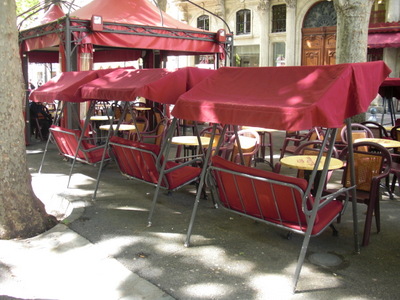
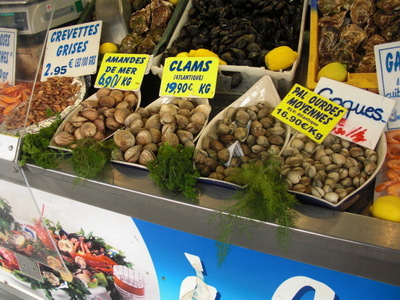 Across from the flowers was this café terrace that included (rather squeaky) porch swings in its seating arrangements. A little farther along was another that did the same thing with wooden porch swings. Charming.
Across from the flowers was this café terrace that included (rather squeaky) porch swings in its seating arrangements. A little farther along was another that did the same thing with wooden porch swings. Charming.
Off to one side was a single seafood stall (it was Friday, after all), selling raw seafood off one side and cooked take-out seafood off the other. At the right are several species of clams, only one of which is called "clams" in French. Note that "sea almonds" are way cheaper than "medium palourdes," in turn cheaper than "clams." The price of cockles is hidden.
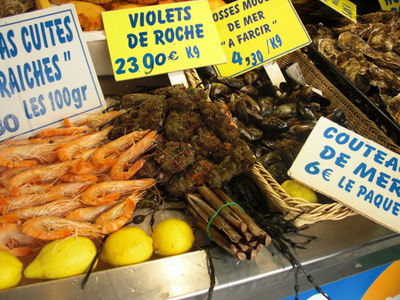
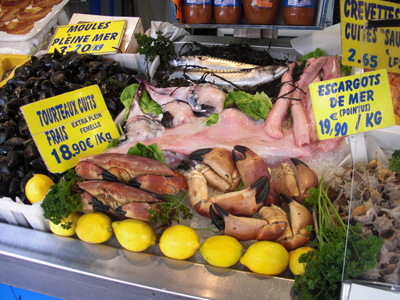 Here on the left the stand is selling "violets de roche" ("rock violets," also apparently called "sea figs"), which it seems are rare and expensive. They look like muddy, shapeless blobs, but according to Wikipedia they are edible ascidean tunicates, egg-yolk yellow inside. In front of them, held together in a bundle with a green rubber band, are "couteaux de mer" ("sea knives"), a delicious kind of razor clam.
Here on the left the stand is selling "violets de roche" ("rock violets," also apparently called "sea figs"), which it seems are rare and expensive. They look like muddy, shapeless blobs, but according to Wikipedia they are edible ascidean tunicates, egg-yolk yellow inside. In front of them, held together in a bundle with a green rubber band, are "couteaux de mer" ("sea knives"), a delicious kind of razor clam.
On the right are assorted seafoods, including (behind the "escargots de mer" sign), eels, skinned and ready to cook. The escargots de mer (sea snails) themselves are at the right front. The label specifies that they are "pointus" (pointed), i.e., armed all over with sharp points, as opposed to ordinary "bulots" (whelks), which are also sea snails and about the same size but way less spiky. The whole cooked crabs ("tourteaux") are labeled "extra full females."
Written 25 May
After seeing what there was to see at the flower market, we checked out of the hotel, extricated the car from from its place in the hotel's second subbasement and set off for Narbonne. Again the GPS took us by the toll-paying freeway, but along that stretch other choices are pretty meager anyway.
It took us right to the door of the Hotel du Midi, where we parked directly in front of the closed garage door and presented ourselves at reception. The rooms wouldn't be ready until after 3 p.m. (it was only noon at the time), but the owner let us into the locked garage, where our luggage would be perfectly safe in the car until then, and set off toward the center of the old town in search of lunch.
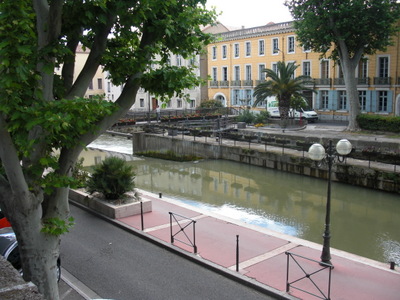
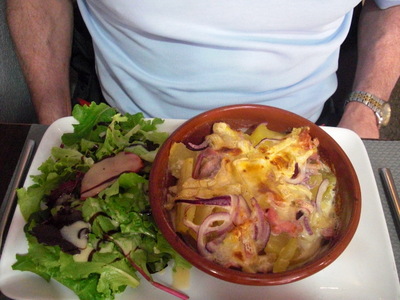 On the way, we crossed the Canal de la Robine—a section of the Canal du Midi—then walked along it. On the left is a photo of a lock (you can only see the downstream half of it, along the far side of the canal) and along the lock's near side, a weir, which formed about an 8-foot waterfall.
On the way, we crossed the Canal de la Robine—a section of the Canal du Midi—then walked along it. On the left is a photo of a lock (you can only see the downstream half of it, along the far side of the canal) and along the lock's near side, a weir, which formed about an 8-foot waterfall.
We settled at "l'Agora" in the Town Hall square for lunch. David had a tartiflette, shown at the right. I think I've mentioned in previous diaries that the makers of Reblochon cheese invented the tartiflette within recent memory, but it's a winner—slices of cooked potatoes, lardons, and onions doused with cream, topped liberally with Reblochon, and baked until hot and bubbly. Yum.
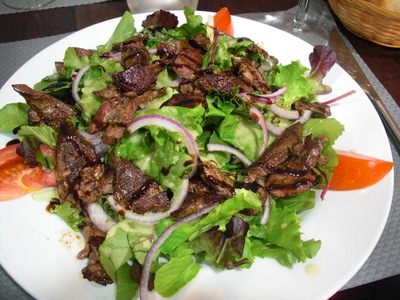
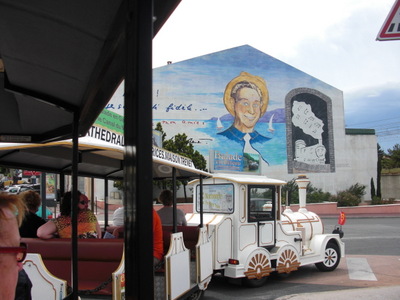 I had an onion and chicken-liver salad. Also yum.
I had an onion and chicken-liver salad. Also yum.
while we ate, we were entertained by a couple of scruffy young people busking in the square. He rode a unicycle (falling off frequently), she tossed one of those tasselled sticks between two smaller sticks (dropping it often). They both juggled reasonably well. They seemed to be travelling by bicycle and were accompanied by a pack of four large dogs; if the dogs did tricks, we didn't see them.
Next was a stop at the nearby Office de Tourism. No, the city's guided walking tours didn't start until school vacation. No, they didn't have audioguides or even brochures to fill in in the meantime (even though the sidewalks were studded with the familiar little brass medallions marking the route). We were able to collect a city map and museum brochures before repairing to the handsome Cour Mirabeau, a tree-shaded esplanade along the canal, to catch the Little White Train. Iconic French singer Charles Trenet (1913–2001) was a native of Narbonne (the little brass plaques in the sidewalks show his face), and I was able to catch this good photo of the Little White Train as it rounded a curve below a mural featuring a self-potrait of Trenet. The train in the mural represents not the little tourist train but the real railroad, which (maybe 3 blocks from this mural) runs by about 20 feet from the front door of the Trenet house, now a museum dedicated to the singer.
Despite its traditional design (compare the 21st century version in my 18 June 2009 diary entry), this was an especially good train; its wheels were quiet, it didn't clank and squeak incessantly as many do, and its sound system was perfect—we could hear and understand every word. It provided quite a comprehensive 45-minute tour of the Roman and Medieval sections of the old city, plus of course loop past Trenet's house.
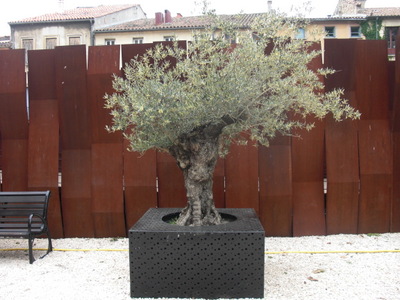
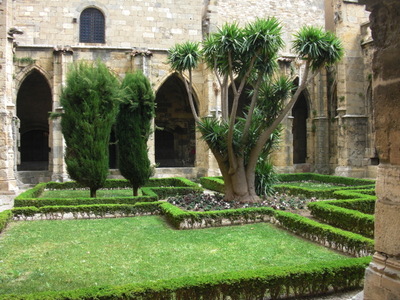 From the train, we strolled to the bishop's garden and terrace, only a few steps, as the gigantic bishop's palace houses the city's vast museum of archeology (prehistory to the present), its somewhat smaller museum of art and history, and the Donjon Gilles (a massive square tower with a panoramic view of the city) as well as the Two Hall and mayor's office, so it faces right on the square where we had lunch and from which you can see both the Office de Tourism in one direction and the little white train in the other.
From the train, we strolled to the bishop's garden and terrace, only a few steps, as the gigantic bishop's palace houses the city's vast museum of archeology (prehistory to the present), its somewhat smaller museum of art and history, and the Donjon Gilles (a massive square tower with a panoramic view of the city) as well as the Two Hall and mayor's office, so it faces right on the square where we had lunch and from which you can see both the Office de Tourism in one direction and the little white train in the other.
The garden is small but pleasant. It includes a modern fountain that also serves as a sundial, a number of these ancient container-grown olives trees (which were heavily in bud), and a stone plaque bearing a lovely poem to the effect that, if the artist were a tree, he would like to stand in a small privet-bounded cemetery where on Sunday afternoons he could watch people come to look at the stones, lay flowers, perhaps clear the moss from someone's name and then the rest of the week shade those who stayed longer.
It also had a widely varied selection of container-grown citrus trees. They weren't labeled, but we had apparently only just missed the flowering season, as most had set tiny fruit. From the garden, a ramp led up to the bishop's terrace, which you could look at but not walk on. It's now planted with many different sizes and colors of Sedum, many in flower.
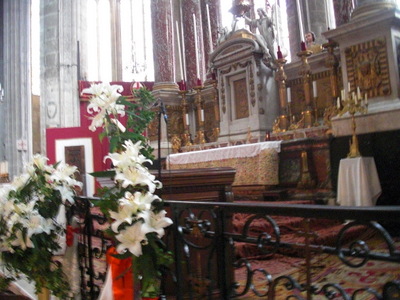
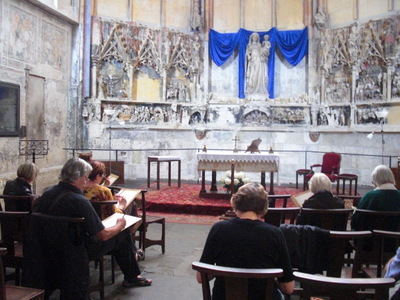 From the garden, we entered the Cathedral Saint-Just-et-Saint-Pasteur (immediately adjacent to the bishop's palace), which is quite tall but very short from front to back, as it was never finished and consists only of the choir and first few bays of the nave. For some reason, it was heavily decorated with white lilies that day, so their scent was everywhere.
From the garden, we entered the Cathedral Saint-Just-et-Saint-Pasteur (immediately adjacent to the bishop's palace), which is quite tall but very short from front to back, as it was never finished and consists only of the choir and first few bays of the nave. For some reason, it was heavily decorated with white lilies that day, so their scent was everywhere.
In one of the side chapels, from which most of the decor had been removed and where most of the rest was heavily damaged, a bright blue hanging had been placed behind the single central statue of the madonna and child to make them stand out in sharp relief. An adult art class was busy drawing them while we were there.
That evening was one of the few on this trip on which we had to drive to dinner, and getting there was considerably less than half the fun. The restaurant was Le Portanel, in Bages, on a promontory jutting into l'Etang de Bages-Sigean, a vast lagoon on the coast of the Mediterranean. Its address was extremely vague, just "La Placette, Bages" (the Little Square, Bages). The GPS claimed to know just where it was, and gave us driving directions right to its door, but I knew from the restaurant's website that it was in a pedestrian zone. Sure enough, when we got within half a mile of it, it was a couple of hundred feet over our heads, up a sheer cliff, and at least two of the streets that the GPS wanted us to turn onto were, in fact, staircases. But that was the least of our worries . . .
We allowed a half hour for the drive, which Google said should take 11 minutes, but when we set out, not a hundred yards from our hotel, we made a wrong turn out of a rotary. Although we realized it the moment it happened, we couldn't seem to recover from the error. Our attempts to get back onto the original route just made things worse, and the GPS revised its estimate of the distance and time, and we just followed its recommendations, out into the vines and countryside, and eventually returned to the original route rather later than we intended. We were maybe 10 minutes late for our 8 p.m. reservation when we reached the town, which was quite small but turned out to be nearly vertical maze of one-way streets, of which were labeled. we took a road on my Google map that traced the edge of the promontory, describing a loop around the location of the restaurant, which, as I mentioned above was far above our heads, invisible and inaccessible. Every possible nook in which one could pull over or park was already occupied. The road led back off the promontory, and before we realized it we'd missed the last chance to loop back toward it. The road was very narrow, with marsh or lagoon on both sides, no possible way to turn around, and other drivers behind us! Aargh. The GPS was having hysterics (silently, fortunately, as we always keep the sound off) but recalculated repeatedly and kept trying to get us back to the restaurant. We wound up, at one point, farther away from it than we had been at the start of the trip, but eventually completed a large circuit (on, for a large part of the time, what the GPS called "unnamed road") that brought us back to the road into town. We made a different choice of street this time and got a little closer before finding—at last!—a parking space. We pulled over, got out, and hiked back along deserted streets and staircases in the general direction of the restaurant. Eventually, we came to a tiny stone square (La Placette?!) hemmed in by ancient stone buildings where an equally tiny bar still had its lights on. I asked for help, and we were directed up a steep narrow alley, under a stone arch, then down to the right, and look for the sign. That's when we finally came to La Placette, which, although clearly labeled, was—seriously—no bigger than my hotel room and a sign directing us a few feet down another narrow alley to the restaurant's warmly lighted entrance. We were about 45 minutes late for our reservation, but the proprietor waved aside our apology; no problem at all, madam. I image she was glad we'd showed up in the end. I'm sure many of their clients just give up and go home again, as David was beginning to suggest we should.
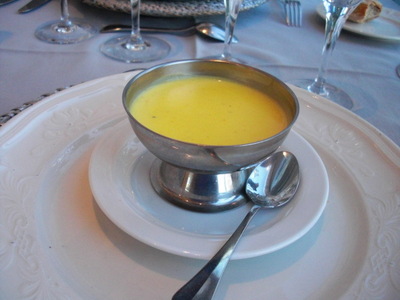
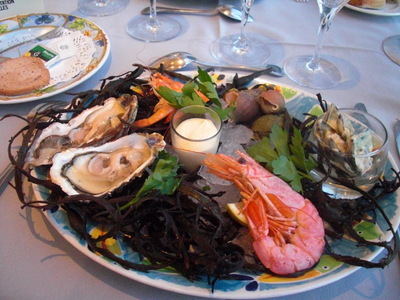 The food, though, was very good.
The food, though, was very good.
Amuse-bouche: A smooth, creamy hot mussel soup, brightly colored with turmeric and/or saffron. Delicious.
First course, David (not shown): A dark reddish-brown soup of "cranquettes" (local she-crabs), topped with a big dollop of cream.
First course, me: Mixed cold seafood: two oysters, three cooked shrimp, three "bulots" (whelks), four cooked mussels (on the half shell and tossed, shells and all, in a mayo-based sauce and stood in a glass), and a "gamba" (a large prawn). It was all arrayed on a plate covered with Fucus and cracked ice around a small glass in the center filled with home-made mayo. All delicious, and because no crab or lobster or unshucked molluscs were involved, reasonably quick to eat. They provided a disposable wet-nap, but I still had to go wash my hands afterward.
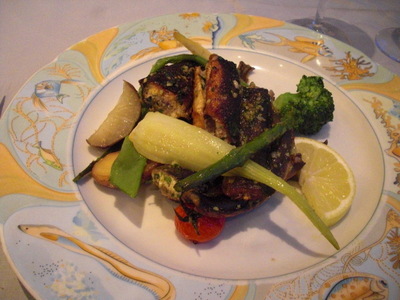
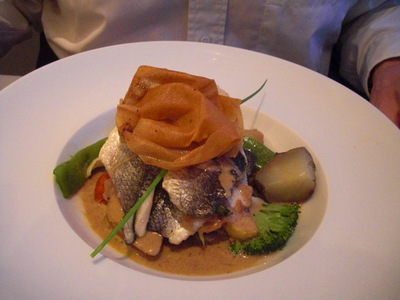 Main course, David: A layered structure of filets of "loup" (Dicentrarchus labrax, aka "bar" or "branzini") and vegetables. The waitress warned us as sh served the dish that the potato-like object at the right was in fact a "topinambour" (Helianthus tuberosus, sunchoke or Jerusalem artichoke). The object on top of the fish is a sheet of "brik" pastry crumpled into a rose-like shape and baked until crisp and brown.
Main course, David: A layered structure of filets of "loup" (Dicentrarchus labrax, aka "bar" or "branzini") and vegetables. The waitress warned us as sh served the dish that the potato-like object at the right was in fact a "topinambour" (Helianthus tuberosus, sunchoke or Jerusalem artichoke). The object on top of the fish is a sheet of "brik" pastry crumpled into a rose-like shape and baked until crisp and brown.
Main course, me: Eel from the lagoon we were overlooking, simply sautéed with garlic and parsley, also stacked up with an assortment of roasted vegetables (broccoli, broad green bean, asparagus, parsnip, fennel, superb cherry tomato). I also got a topinambour, but a real potato is also visible, just below it. It was great, beating that 2011 eel "au vert" in Brussels all hollow. My serving was one whole eel, chopped into sections. Delicious.
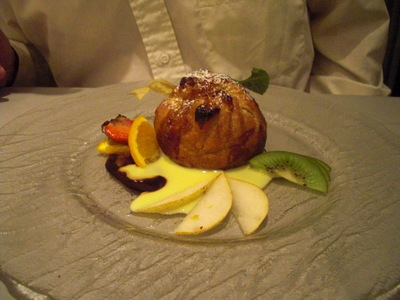
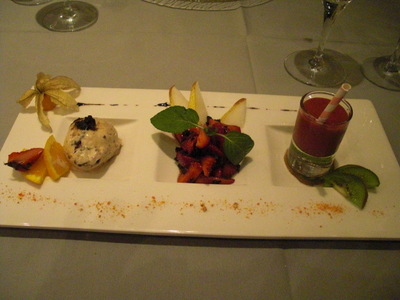 Dessert, David: A "figuette narbonnaise," consisting of thin sheet of puff pastry wrapped around almond flavored cream and, in the center, a sugar-preserved fig, all baked until crispy. I found it too sweet, but he liked it.
Dessert, David: A "figuette narbonnaise," consisting of thin sheet of puff pastry wrapped around almond flavored cream and, in the center, a sugar-preserved fig, all baked until crispy. I found it too sweet, but he liked it.
Dessert, me: Variations on strawberries and black olives. On the right, a vinegary (but delicious) strawberry gazpacho. In the middle, a fruit salad of sugared strawberries and minced black olives. On the left, a caramel-strawberry ice cream with minced black olives. Odd, but all good.
Then came the double difficulty of (a) finding the car again and (b) getting out of town without winding up back in that maze of unnamed roads. I studied my little Google map carefully and formed a hypothesis about where the car was (unfortunately, on a one-way street out of town toward the wilderness, just "downstream" of a short cross street leading to a much more promising route. We consulted the proprietor and the waitress, who could now tell us whether or not route D105 was one-way but who pointed out a simpler shortcut back to the point where I thought the car was. We decided to gamble that I was right, followed that route, and sure enough, there was the car! And as we passed the little cross street, a car went by in the "other" direction—it was two-way! If we could just get down there, we'd be home free. So, looking both ways on the dark, deserted (and fortunately fairly wide) street, I executed a three-point turn (momentarily delaying another car that of course appeared just as I had the street blocked), drove three car lengths the wrong way up the one-way street, turned down the side street, took a left on the two-way route 105, and we were home in the promised 13 minutes. Piece of cake.
previous entry
List of Entries
next entry

 When he did appear, we strolled up the street toward the market place and famous statue of Pierre Paul Riquet (1609–1680), shown here on the left. He's the local native son who finally solved the problem of getting the Canal du Midi over the Seuil de Naurouze (a ridge that had baffled all previous attempts) so that it could at last join the Atlantic to the Mediterranean—a huge boon to shipping. To get a canal over a high spot that you can't cut a slot through, you need a source of water at the top with which to fill the locks (on a one-way slope, you just use water from the canal, whichever end is higher), like Gatun lake on the Panama Canal. Riquet located a spring at the top of the ridge and figured out how to supplement its flow with water piped in from distant mountains, so that locks could be built down both sides of the ridge. He actually paid for about a third of the project personally (and we're talking 10,000 to 12,000 workers for several years), hoping to repay his debts from tolls once the canal opened, but he died just before it did.
When he did appear, we strolled up the street toward the market place and famous statue of Pierre Paul Riquet (1609–1680), shown here on the left. He's the local native son who finally solved the problem of getting the Canal du Midi over the Seuil de Naurouze (a ridge that had baffled all previous attempts) so that it could at last join the Atlantic to the Mediterranean—a huge boon to shipping. To get a canal over a high spot that you can't cut a slot through, you need a source of water at the top with which to fill the locks (on a one-way slope, you just use water from the canal, whichever end is higher), like Gatun lake on the Panama Canal. Riquet located a spring at the top of the ridge and figured out how to supplement its flow with water piped in from distant mountains, so that locks could be built down both sides of the ridge. He actually paid for about a third of the project personally (and we're talking 10,000 to 12,000 workers for several years), hoping to repay his debts from tolls once the canal opened, but he died just before it did.
 Across from the flowers was this café terrace that included (rather squeaky) porch swings in its seating arrangements. A little farther along was another that did the same thing with wooden porch swings. Charming.
Across from the flowers was this café terrace that included (rather squeaky) porch swings in its seating arrangements. A little farther along was another that did the same thing with wooden porch swings. Charming.
 Here on the left the stand is selling "violets de roche" ("rock violets," also apparently called "sea figs"), which it seems are rare and expensive. They look like muddy, shapeless blobs, but according to Wikipedia they are edible ascidean tunicates, egg-yolk yellow inside. In front of them, held together in a bundle with a green rubber band, are "couteaux de mer" ("sea knives"), a delicious kind of razor clam.
Here on the left the stand is selling "violets de roche" ("rock violets," also apparently called "sea figs"), which it seems are rare and expensive. They look like muddy, shapeless blobs, but according to Wikipedia they are edible ascidean tunicates, egg-yolk yellow inside. In front of them, held together in a bundle with a green rubber band, are "couteaux de mer" ("sea knives"), a delicious kind of razor clam.
 On the way, we crossed the Canal de la Robine—a section of the Canal du Midi—then walked along it. On the left is a photo of a lock (you can only see the downstream half of it, along the far side of the canal) and along the lock's near side, a weir, which formed about an 8-foot waterfall.
On the way, we crossed the Canal de la Robine—a section of the Canal du Midi—then walked along it. On the left is a photo of a lock (you can only see the downstream half of it, along the far side of the canal) and along the lock's near side, a weir, which formed about an 8-foot waterfall.
 I had an onion and chicken-liver salad. Also yum.
I had an onion and chicken-liver salad. Also yum.

 From the train, we strolled to the bishop's garden and terrace, only a few steps, as the gigantic bishop's palace houses the city's vast museum of archeology (prehistory to the present), its somewhat smaller museum of art and history, and the Donjon Gilles (a massive square tower with a panoramic view of the city) as well as the Two Hall and mayor's office, so it faces right on the square where we had lunch and from which you can see both the Office de Tourism in one direction and the little white train in the other.
From the train, we strolled to the bishop's garden and terrace, only a few steps, as the gigantic bishop's palace houses the city's vast museum of archeology (prehistory to the present), its somewhat smaller museum of art and history, and the Donjon Gilles (a massive square tower with a panoramic view of the city) as well as the Two Hall and mayor's office, so it faces right on the square where we had lunch and from which you can see both the Office de Tourism in one direction and the little white train in the other.

 From the garden, we entered the Cathedral Saint-Just-et-Saint-Pasteur (immediately adjacent to the bishop's palace), which is quite tall but very short from front to back, as it was never finished and consists only of the choir and first few bays of the nave. For some reason, it was heavily decorated with white lilies that day, so their scent was everywhere.
From the garden, we entered the Cathedral Saint-Just-et-Saint-Pasteur (immediately adjacent to the bishop's palace), which is quite tall but very short from front to back, as it was never finished and consists only of the choir and first few bays of the nave. For some reason, it was heavily decorated with white lilies that day, so their scent was everywhere.
 The food, though, was very good.
The food, though, was very good.
 Main course, David: A layered structure of filets of "loup" (Dicentrarchus labrax, aka "bar" or "branzini") and vegetables. The waitress warned us as sh served the dish that the potato-like object at the right was in fact a "topinambour" (Helianthus tuberosus, sunchoke or Jerusalem artichoke). The object on top of the fish is a sheet of "brik" pastry crumpled into a rose-like shape and baked until crisp and brown.
Main course, David: A layered structure of filets of "loup" (Dicentrarchus labrax, aka "bar" or "branzini") and vegetables. The waitress warned us as sh served the dish that the potato-like object at the right was in fact a "topinambour" (Helianthus tuberosus, sunchoke or Jerusalem artichoke). The object on top of the fish is a sheet of "brik" pastry crumpled into a rose-like shape and baked until crisp and brown.
 Dessert, David: A "figuette narbonnaise," consisting of thin sheet of puff pastry wrapped around almond flavored cream and, in the center, a sugar-preserved fig, all baked until crispy. I found it too sweet, but he liked it.
Dessert, David: A "figuette narbonnaise," consisting of thin sheet of puff pastry wrapped around almond flavored cream and, in the center, a sugar-preserved fig, all baked until crispy. I found it too sweet, but he liked it.